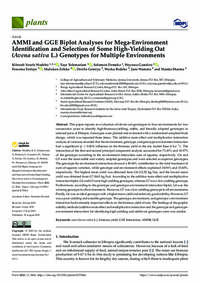AMMI and GGE Biplot Analyses for Mega-Environment Identification and Selection of Some High-Yielding Oat (Avena sativa L.) Genotypes for Multiple Environments

Authors:
This paper reports an evaluation of eleven oat genotypes in four environments for two consecutive years to identify high-biomass-yielding, stable, and broadly adapted genotypes in selected parts of Ethiopia. Genotypes were planted and evaluated with a randomized complete block design, which was repeated three times. The additive main effect and multiplicative interaction analysis of variances revealed that the environment, genotype, and genotype–environment interaction had a significant (p ≤ 0.001) influence on the biomass yield in the dry matter base (t ha−1). The interaction of the first and second principal component analysis accounted for 73.43% and 14.97% of the genotype according to the environment interaction sum of squares, respectively. G6 and G5 were the most stable and widely adapted genotypes and were selected as superior genotypes. The genotype-by-environment interaction showed a 49.46% contribution to the total treatment of sum-of-squares variation, while genotype and environment effects explained 34.94% and 15.60%, respectively. The highest mean yield was obtained from G6 (12.52 kg/ha), and the lowest mean yield was obtained from G7 (8.65 kg/ha). According to the additive main effect and multiplicative interaction biplot, G6 and G5 were high-yielding genotypes, whereas G7 was a low-yielding genotype. Furthermore, according to the genotype and genotype–environment interaction biplot, G6 was the winning genotype in all environments. However, G7 was a low-yielding genotype in all environments. Finally, G6 was an ideal genotype with a higher mean yield and relatively good stability. However, G7 was a poor-yielding and unstable genotype. The genotype, environment, and genotype x environment interaction had extremely important effects on the biomass yield of oats. The findings of the graphic stability methods (additive main effect and multiplicative interaction and the genotype and genotype–environment interaction) for identifying high-yielding and stable oat genotypes were very similar.
